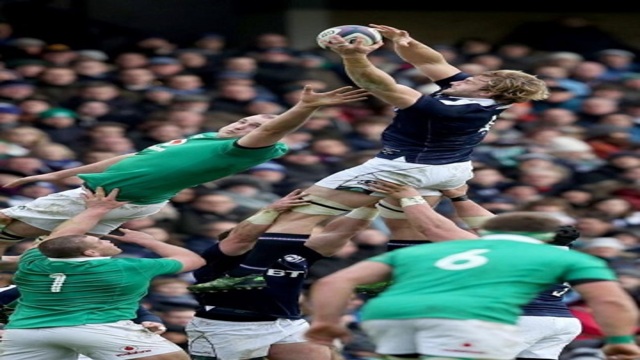How to use ‘gadgets’ at the lineout
In his modules on The Rugby Site, Sir Graham Henry insists that the contemporary model relationship between coaches and players is one of cooperation and empowerment, not one of authority on one side and obedience on the other.
A pertinent and very recent example of this reciprocal relationship occurred before the Scotland-Ireland game, in the first round of the Six Nations tournament last weekend. The Scotland forwards coach Jonathan Humphreys revealed after the match, that a lineout ‘gadget’ call which resulted directly in a try for Scotland had been suggested by the on-field lineout captain Jonny Gray prior to the game. According to Humphreys,
‘People don’t realise we tried that move against Tonga two years ago and Alex (Dunbar) dropped the ball. They know it now though…’We identified the possibility that it could work against Ireland. We came to the team run on Friday and Jonny Gray said, “Shall we go through that move?”
But I said, “Nah”.
‘So in reality Jonny should be taking the credit for persevering with it. I’ll give it to him.’
In his module on the lineout, ex-England lineout captain Geoff Parling speaks about the importance of mental attributes – the capacity of a lineout leader to maintain composure and clarity throughout a game, and to remember opposition habits and potential weaknesses unearthed by pre-game analysis coolly in the heat of play.
At a critical point in the Ireland game, Gray’s lineout brain hit on the move identified in Scotland’s preparation – the one discarded by Jonathan Humphreys but retained by the Scotland second row giant.
This example also links to Graham Henry’s outline of ‘natural weaknesses’ in defensive structures. Formations adopted by defences at lineout time could be called ‘micro-weaknesses’ rather than the ‘macro-weaknesses’ he talks about.
Every lineout tends to split into pods of defenders. In the full lineout, the seven players will often split into two groups of three (with a counter jumper at the centre of each), and one spare man – typically a front-rower. Intelligent attacking teams will occasionally examine ways of increasing the natural split between these groups in order to create a line-breaking or scoring opportunity.
In the Scotland example, there are three Scotland backs stacked at the front of the line (#’s 9, 10 and 12), opposite the Ireland spare man (#2 Rory Best). As Paul O’Connell suggests in his commentary, Ireland have loaded their two jumping pods toward the back half of the line, which means that the two defenders beyond Best (#3 Tadhg Furlong and #8 Jamie Heaslip) are both looking away from the ball as it’s thrown in.
Once the throw reaches the Scotland #12 Alex Dunbar, the only defender capable of stopping him (Furlong) has already turned in the opposite direction, only looking around in time to see Dunbar plunge over the goal-line for a try!
A second example based on the same theory with variation, occurred in the Guinness Pro 12 match between Leinster and Ulster:
This sequence occurs well outside the Ulster 22m line, so the possibility of stacking the backs at the front of the line is not realistic.
Instead, Leinster look to widen the gap between the spare man at the front and the first pod of three defensive forwards by having their own jumping crew cycle backwards and fake a jump on Hayden Triggs (with the beard). Triggs gets up in the air and this draws in the key defender (with the black hat), creating a gap for the Leinster #9 Luke McGrath to run through and score, off a nice transfer by prop Jack McGrath.
Perhaps the most famous example of the manipulation of space to exploit a micro-weakness at lineout occurred in the World Cup final between New Zealand and France in 2011.
In this case, the All Black coaches had identified an area in the middle of the line where they believed they could split the two French jumping pods and create space to inject an attacker close to the goal-line.
They called the move ‘Teabag’, a nick-name derived from their veteran loose-head prop Tony Woodcock, who was the key runner on the move.
Here the All Black plan is to widen the gap between the two French three-man pods, knowing that they would likely take the risk of mounting a contest on the ball in the air. There is a fake by Sam Whitelock to commit the French pod at the front, but instead the throw is delivered to Jerome Kaino at the back. He is standing on the 15 metre line in order to maximise the target area for Woodcock through the middle of the line.
As the ball is knocked down to Woodcock, the two All Black forwards near the front (#8 Kieran Read and #5 Whitelock) are careful to screen off their opposites legally so that they cannot reach Woodcock, which means that the prop only has to beat Nicolas Mas, who has to come back quickly from making the effort to lift Julien Bonnaire at the back. In the event, Mas is too far away to matter and Woodcock canters on to score New Zealand’s decisive try of the game.
Summary
All three examples are great instances of both the composure of lineout leaders, remembering potential weaknesses from weekly preparation and making the right call in the heat of the moment; and also of the importance of identifying ‘micro-weaknesses’ within larger defensive structures.
The closer to set-piece a weakness can be pin-pointed, the more likely it is to result in a score. That score could be the difference between winning and losing.
“The art of war is simple enough. Find where your enemy is. Get at him as soon as you can. Strike him as hard as you can, and keep moving on.” (Ulysses S. Grant)


